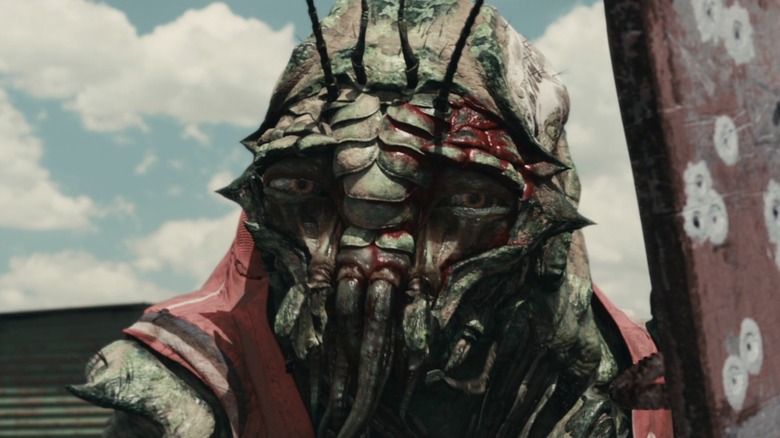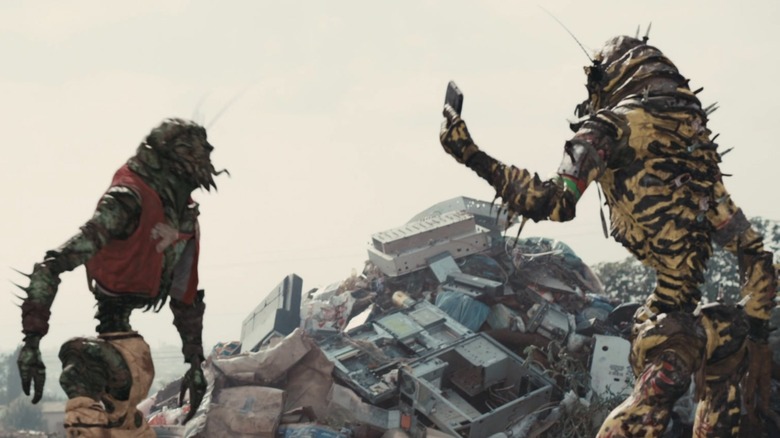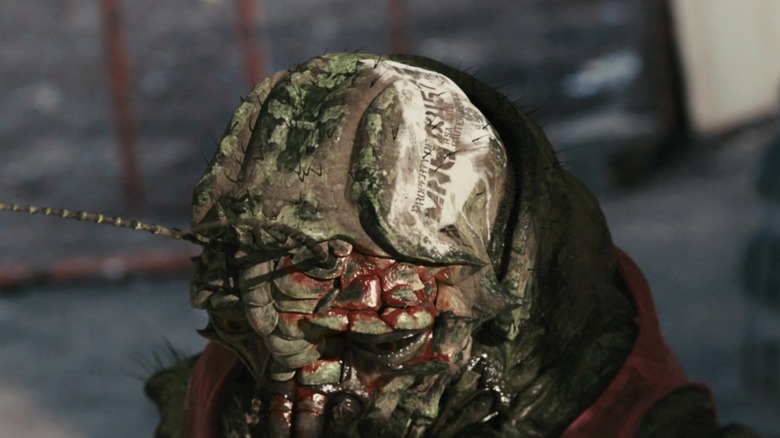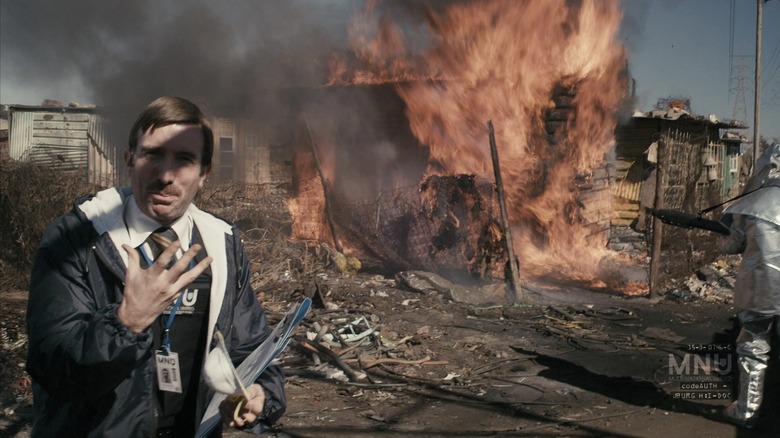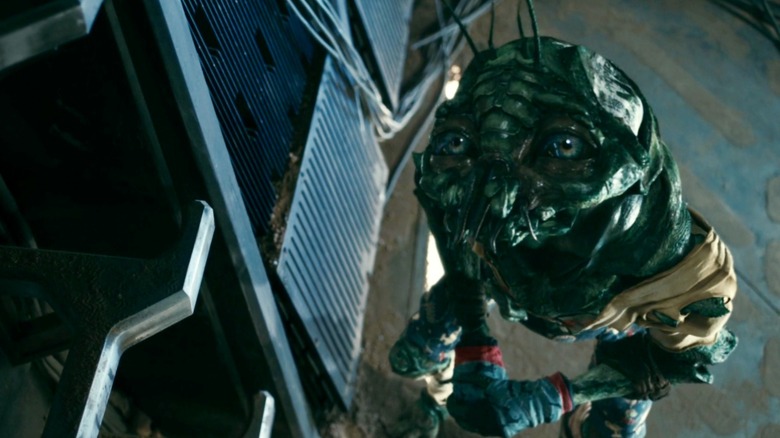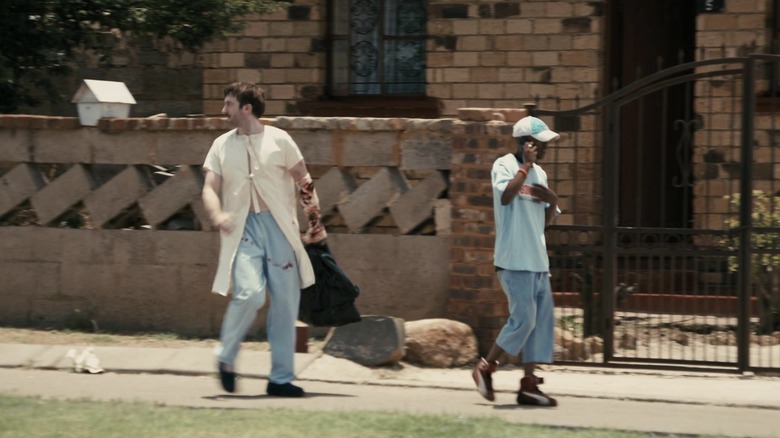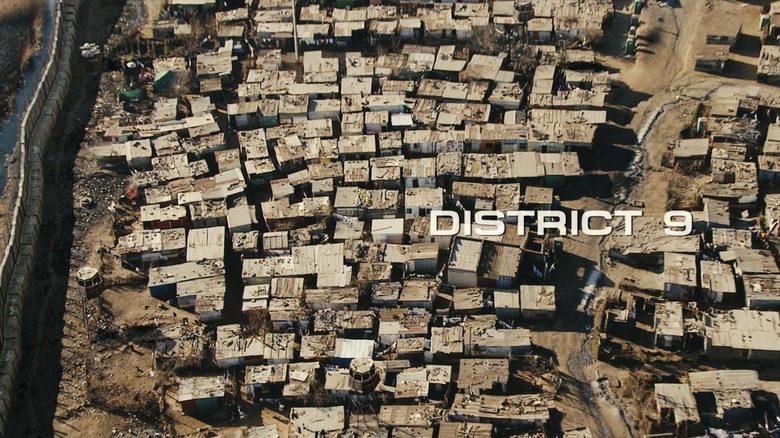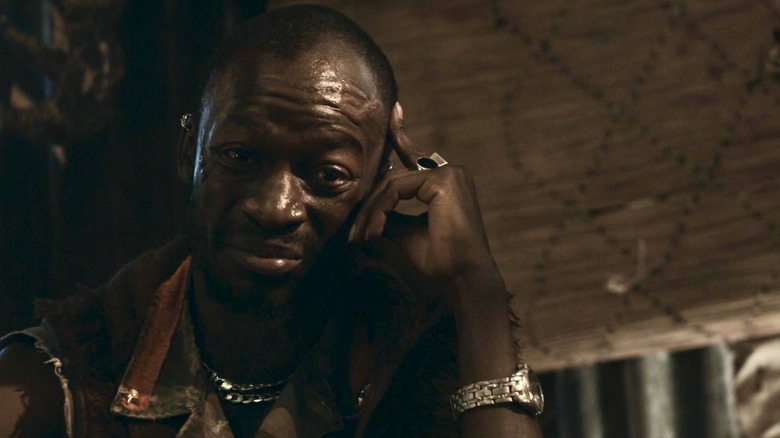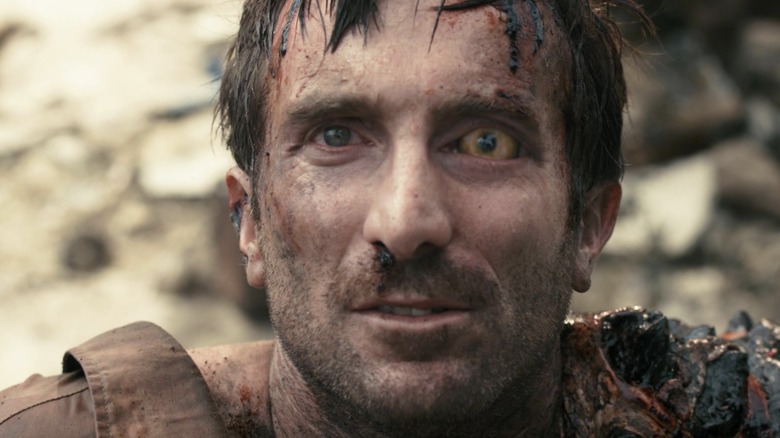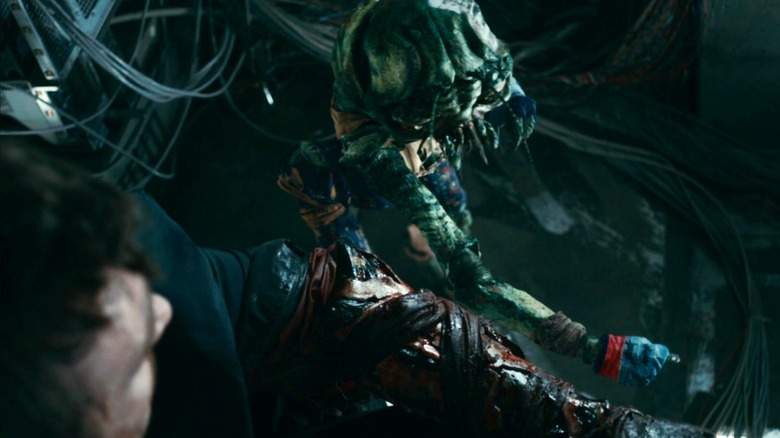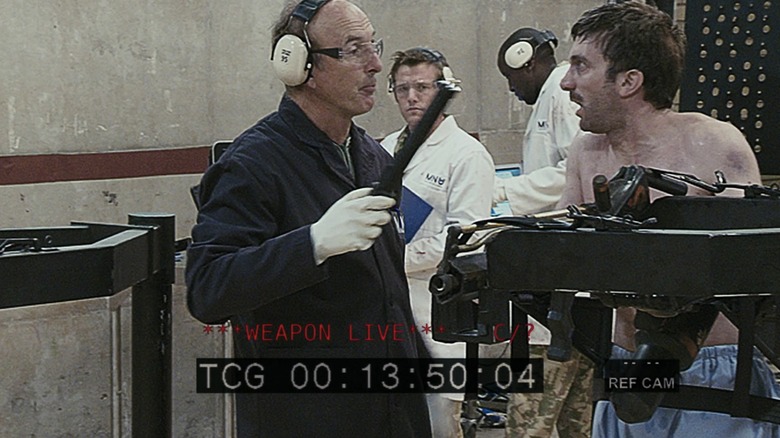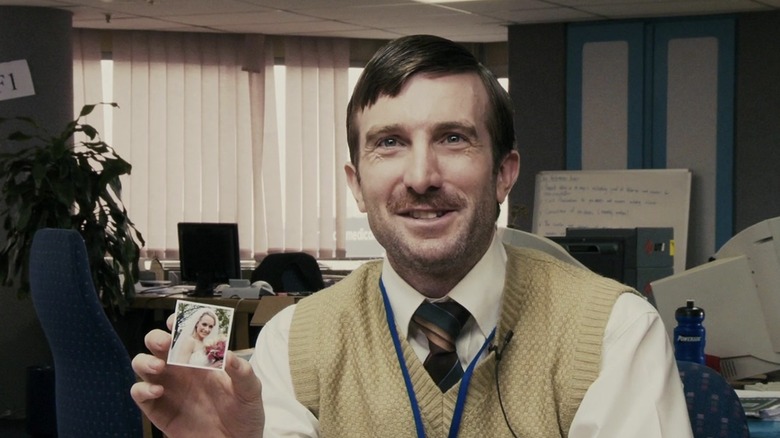Things In District 9 You Notice After Watching More Than Once
Neill Blomkamp's "District 9" was a box office hit and was embraced by audiences and critics alike, securing the coveted "must-see" rating on Metacritic and a "certified fresh" score on Rotten Tomatoes. It was also popular with the Academy, garnering four Oscar nominations, including best picture and best adapted screenplay, which is an impressive feat for a genre film. Peter Jackson, of "The Lord of the Rings" fame, produced this sci-fi movie, and it was Blomkamp's directorial debut, establishing him as a young director to watch out for.
"District 9" is an exploration of racism, segregation, xenophobia, and immigration that is both thought-provoking and entertaining, striking the perfect balance between a movie with a message and a popcorn flick; this was the co-writer/director's aim. Blomkamp told Entertainment Weekly, "I'm not trying to make something about apartheid that beats people over the head. I'm just trying to portray science fiction in a way that feels like it might have actually been real."
The mockumentary framing device Blomkamp employed quickly explains how aliens arrived in South Africa in 1982 and have lived as refugees in a makeshift settlement, called District 9, that has devolved into a slum in the 20-plus years since they arrived. A camera crew follows Wikus van de Merwe (Sharlto Copley) to document the MNU-sponsored relocation of the aliens to District 10, a new refugee settlement outside the city limits, because of widespread anti-alien sentiments in Johannesburg. Join us as we take a deep dive, exploring things you notice after watching "District 9" more than once.
There is variation in the color of the aliens
After watching "District 9" a few times, you may notice the aliens have a variety of contrasting colors painted on their bodies. At the end of a Q&A session led by Adam Savage, after a screening at San Francisco's Alamo Drafthouse, an audience member asked if there was any significance to the variation in color displayed on the alien's bodies. Director Blomkamp said, "No. That was pure ... that was pure sci-fi," suggesting the variation does not connote a difference in heritage or social standing within their alien society.
Although the colors have no significance regarding their social organization, you may have noticed the colors represent the pan-African colors of red, gold, and green. While Christopher Johnson (Jason Cope) has an overwhelmingly green hue, his friend who is killed at the beginning of the film during the relocation effort has a yellow hue, and other aliens throughout the film have a red hue. Using these particular colors that appear on the flags of many African nations suggests a message about cultivating a more inclusive and unified African identity to combat xenophobia and discrimination against refugees from various African countries.
The aliens in District 9 are marked with a serial number
At the end of a Q&A with Adam Savage, Blomkamp confirmed the aliens in "District 9" are marked with a serial number to identify them. In several scenes, you will notice Christopher Johnson has "Property of MNU" stamped in black on the left side of his head after they painted his head white. This serial number creates a visual parallel between chattel slavery in the United States, the Nazis who marked Jews imprisoned in Auschwitz with a tattooed serial number during the Holocaust, and the non-governmental organization Multi-National United (MNU) in this dystopian sci-fi flick.
From the wording of these stamps, it is clear MNU isn't just using serial numbers to identify the aliens living in District 9, but that the organization views the aliens as property rather than refugees living in a settlement. The aliens are regarded as something less than human. The stamp on their heads emphasizes this attitude, as does the derogatory slur "Prawn" used by Johannesburg residents to refer to the aliens. The links to Nazi Germany's treatment of Jewish residents are also echoed later in the film when Wikus tells Christopher Johnson he shouldn't go to District 10 because it is worse than District 9 and "like a concentration camp."
The MNU practices population control by destroying the aliens' eggs
One of the first truly disturbing scenes in "District 9," which highlights the social commentary in the film, depicts Wikus, rather gleefully, conducting what he calls a "Prawn abortion" by disconnecting the nutrient tubes from alien eggs and having MNU security soldiers light the nursery shack in District 9 on fire with flamethrowers. Wikus even provides commentary for the film crew while the shack burns, saying, "Do you hear that? That's a popping sound that you're hearing. It's almost like a popcorn. What the egg does is, it pops up. The little guy, what's left of him, pops out there."
Shortly after the nursery shack is burned, we learn killing alien children is illegal, but apparently performing "Prawn abortions" is simply MNU policy, and is something Wikus embraces. As pointed out in an analysis by The Artifice, "Although Wikus follows direct protocol, he fails to recognize that he's exterminating a species. Wikus displays no remorse towards his actions, suggesting that he's adapted to the government's policies."
This disturbing scene draws corollaries between the film and historical instances of forced sterilization as a means of population control of people of color in South Africa both during and after apartheid. Sadly, real-world South Africa and the South Africa depicted in "District 9" are not unique in this shockingly inhumane behavior. Forced sterilization and eugenics programs have also been practiced in the U.S. on BIPOC populations as recently as the 20th century.
Wikus' manipulative methods of extracting signatures establish him as a heartless company man
Wikus employs manipulative methods to extract signatures from the aliens that are being evicted from District 9, suggesting he is a heartless cog in the MNU machine who views the aliens as things rather than people who deserve respect and kindness. MNU determined that they must inform the aliens of their eviction 24 hours before they are moved, and they must sign paperwork acknowledging they were informed of the eviction and relocation to District 10.
Wikus tricks an alien by saying the alien will receive a can of cat food (which is an alien delicacy) in exchange for signing the paperwork. Wikus also uses laws to evict alien residents in District 9, telling them they are in violation of codes and ordinances to pressure them into signing so they won't have to pay fines. He also uses the discovery of illegal weapons in their residence, which marks them as gang members and criminals, to speed up the eviction process.
When Christopher Johnson says he won't sign the paperwork because the eviction is illegal, Wikus threatens to take away Christopher's son, CJ, saying the garbage around the shack makes the residence not suitable for CJ to live in and that Wikus is legally obligated to take CJ to social services. In "District 9," the foster care system has been weaponized against the impoverished aliens, mirroring native children being removed from their family homes at alarming rates in the U.S.
Wikus immediately adopts the unsavory behaviors the aliens are accused of
In "District 9," Johannesburg residents regard the aliens as violent criminals and aimless scavengers. According to Human Rights Watch, undocumented individuals living in South Africa in 2008 suffered from "xenophobic violence," poverty, crime, and unemployment. In "Alive in Joburg," the 2005 short by Blomkamp that inspired "District 9," the resident interviews in the mockumentary portions were taken from real Johannesburg residents speaking about immigrants, and these interviews highlight the poor attitudes about refugees and migrants in South Africa. In a press release, Blomkamp said, "In essence, there is no difference except that in my film we have a group of intergalactic aliens as opposed to illegal aliens" (per Wired).
Wikus immediately adopts criminal behaviors the aliens are accused of, not because he is becoming a "Prawn," but because he has become ostracized and impoverished overnight. Wikus engages in violence to escape the MNU medical facility, and he steals clothing, a cell phone, and food after escaping because he has no other choice. The aliens aren't mindless drones, as the talking heads in the mockumentary suggest. They are refugees who lost their social structure and were imprisoned in a refugee camp that provides for less than their basic needs and doesn't create opportunities for employment outside District 9, perpetuating their poverty. These are issues real-life refugees must contend with while living in refugee encampments. According to Maslow's hierarchy of needs, people must meet their most basic needs before concerning themselves with more lofty goals.
The forced relocation of District 9 has ties to South African and U.S. history
"The prawn doesn't understand the concept of ownership of property. We will go now and say, 'This is our land, please will you go.'" Wikus' statement at the beginning of "District 9" sounds strikingly similar to what the U.S. government told the Indigenous population of North America when a massive forced relocation created the Trail of Tears after the Indian Removal Act was signed into law by President Andrew Jackson.
The forced relocation of District 9 has ties to South African history. According to the South African History Archive, in 1966 District Six was deemed a "whites-only" district because of the 1950 Group Areas Act. Starting in 1968, 60,000 residents of District Six were forced to relocate to the Cape Flats because they were Black or biracial. The homes were demolished and a new "whites-only" district was built. A District Six Museum was created to educate people about its history.
In a Q&A with Adam Savage, Blomkamp spoke about how the neighborhood where he filmed "District 9" was undergoing a forced relocation of residents to government-subsidized housing while the movie was being filmed. The area is called Chiawelo, and Blomkamp called the neighborhood "economically depressed beyond belief." The shacks you see in the film were the homes of residents after relocation. Urban renewal in the U.S. leading to the gentrification of Manhattan's Upper West Side and Cabrini Green in Chicago suggest forced relocation is a widespread issue for residents of impoverished neighborhoods.
Depictions of Nigerians in District 9 mirror negative attitudes about immigrants
Although "District 9" has been lauded for its anti-racism stance, it has also been criticized for the depiction of the Nigerian residents of District 9 who earn a living off the aliens, leaving critics and academics divided. The Mail & Guardian points out that although the film succeeded in eventually making the audience sympathize with the aliens, the Nigerians were depicted as being entirely reprehensible.
In a Q&A with Adam Savage after a screening of the film, Blomkamp acknowledged he was almost banned from Nigeria because of the controversy surrounding the negative depiction of the Nigerians in the film. The "Prawns" and Nigerians are fictional stand-ins for real-world Zimbabwean refugees and other African migrants who immigrated to South Africa for a better life, only to be resented by Indigenous and European South Africans. In her academic paper, Ashton Kirsten argues the director "uses racial stereotypes to show us our national follies and shortcomings in order for us to shift our perspectives and assumptions" about immigrants.
Of course, these negative attitudes about immigrants are not unique to South Africa. We only need to look to the U.S. to see a long history of anti-immigrant sentiment, something that is incredibly ironic, considering the U.S. is made almost entirely of immigrants. Other examples of vitriol directed toward immigrants and refugees in modern times include the Chinese Exclusion Act of 1882 and the anti-immigration rhetoric espoused by Donald Trump.
The smear campaign against Wikus echoes a history of anti-miscegenation laws
When Wikus escapes the medical facility at MNU headquarters, where he was subjected to inhumane and illegal scientific testing, MNU employs a smear campaign against him in the media, spreading the lie that Wikus contracted a sexually transmitted disease from engaging in relations with aliens in District 9. The public reaction of disgust directed at Wikus echoes a history of anti-miscegenation laws in both South Africa and the United States.
In South Africa, the Prohibition of Mixed Marriages Act of 1949 made marriages and sexual relationships between whites and non-whites illegal and wasn't repealed until 1985 when interracial relationships were finally allowed in South Africa (per SAHO). In the U.S., the first anti-miscegenation law went into effect before the U.S. even existed, in Maryland in 1661. Anti-miscegenation laws were not struck down in the U.S. until 1967 when the Supreme Court ruled in favor of the Lovings in the historic Loving v. Virginia case. Of course, just because interracial marriages and relationships were illegal in South Africa and the U.S. doesn't mean they didn't exist, and children were born from these interracial relationships.
The Artifice suggests in their analysis, "If society allows miscegenation, this brings peace and harmony among race relations. However, since society prohibits miscegenation, there exists no balance between humans and aliens." Wikus' metamorphosis in "District 9" is symbolic of mixed-race individuals feeling excluded from both groups and being vulnerable to the same type of discrimination levied against marginalized groups, despite mixed-race individuals sharing ancestry with the oppressor.
Wikus' physical transformation is symbolic of internalized racism
Unlike many "going native" stories, "District 9" isn't about a man who discovers the beauty in another culture and embraces it as Jake Sully (Sam Worthington) in "Avatar" or Lieutenant Dunbar (Kevin Costner) in "Dances with Wolves" do. Wikus is forced to see the humanity in an alien species only after transforming into an alien when he is infected by a mysterious black goo that is both alien rocket fuel and a biological catalyst for interspecies transformation.
The utter revulsion Wikus responds with when he sees his injured arm has transformed into a "Prawn" arm reveals his racism toward the aliens. Wikus even attempts to cut off part of his claw, but experiences horrible pain, proving the arm truly is part of him. The Artifice argues in their analysis Wikus' transformation is symbolic of biracial individuals' frustration with fear of being marginalized and mistreated because of the "one-drop rule." Wikus denies his transformation, telling CJ they are nothing alike when the tiny alien compares their matching arms. Eventually, Wikus' transformation is too complete for him to continue denying, and he finally sees humanity in Christopher and his son CJ. Now, Wikus finally treats the aliens with compassion, rather than being driven solely by self-interest.
In his academic paper, Laszlo Szabo writes, "In 'District 9,' body horror becomes a medium for dehumanization that further stresses the inhumanity of the colonizers." Wikus' transformation into an alien forces him to confront the inherent racism of his culture and the self-loathing he feels as he transforms is a powerful depiction of internalized racism.
The scientific experiments the MNU carries out speak to a history of unethical experimentation
This is the crux of the film. When Wikus becomes a science experiment at the MNU medical laboratory and is forced to fire alien weapons, killing an alien in a particularly upsetting chain of events, he is forced to choose a side. Either he can submit by having his organs harvested for medical research and die, or he can use his newfound alien strength to escape.
During their raid to retrieve the cylinder filled with the black rocket fuel responsible for Wikus' transformation, Christopher sees the experiments being carried out on his people at the MNU medical laboratory. Christopher's horror is made clear by his dejected stance, hanging his head and staring at the corpses of aliens during an intense firefight between Wikus and MNU soldiers. With this revelation, Christopher is moved to help his people — now!
This history of experimenting on prisoners is broad. The Nazis experimented on Jews during the Holocaust, and during WWII the Japanese experimented on Chinese prisoners in Unit 731. This history of unethical experimentation also exists in South Africa. According to PBS, the Truth and Reconciliation Commission shed light on the Chemical and Biological Warfare programs of South Africa's apartheid-era government that targeted the non-white population. Discover Magazine exposed a long history of unethical experiments on "vulnerable populations" in the U.S., from the Tuskegee syphilis study and the CIA's MK-Ultra studies to a "dermatologist who used prisoners as guinea pigs."
The tactical exoskeleton Wikus wears in the final confrontation is a reference to Robocop
Producer Peter Jackson told Entertainment Weekly, "It's an utterly original film. In an industry that's looking to make movies out of every obscure TV show, or sequels, or video games, you look at 'District 9' and it's unlike anything you've ever seen before." While this statement is 100% true, and "District 9" is an inventive film, it is also a love letter to sci-fi, the genre Blomkamp grew up obsessed with. The film is a veritable treasure trove of references to other films, as Empire acknowledged in their review referencing "Alien Nation," "The Fly" and "RoboCop."
The suit Wikus wears to battle the MNU soldiers in a final confrontation, where Wikus sacrifices his hopes of regaining his human form to save Christopher Johnson and CJ so they can travel to the mother-ship hovering over Johannesburg, is a not-so-subtle reference to "RoboCop." The director acknowledged in an interview with FirstShowing that "RoboCop" was one film that influenced him as a filmmaker. We weren't the only ones noticing the striking similarities. NPR said the film features "a cameo by what looks like RoboCop's ED-209."
Blomkamp told Time how his youth in steeped South Africa's history of racism and his love of sci-fi, "just mixed, and I decided I wanted to do science fiction in South Africa" — creating a truly unique film that celebrates an unabashed love of sci-fi while serving up satirical social commentary.
Wikus' final lines might be a reference to Blomkamp's unrealized Halo movie
At the very end of "District 9," we see mockumentary footage of Wikus showing the camera crew a picture of his wife and telling them she is an angel. He shows them a photo from their wedding day, pointing out how her veil even makes it look like she has a halo. While it is a sweet sentiment showcasing Wikus' devotion to his wife, this might be a subtle reference to the "Halo" film project that fell apart before Blomkamp made "District 9." Although Blomkamp's "Halo" movie never materialized, a TV adaptation premiered in March 2022 on Paramount+.
In an interview with FirstShowing, Blomkamp spoke about how it was only after his live-action adaptation of the "Halo" video game fell apart that Peter Jackson suggested Blomkamp develop a feature-length film inspired by his short film, "Alive in Joburg." That twist of fate gave Blomkamp his own sci-fi franchise to develop. As reported by Sci Fi Wire, the director has teased the possibility of a sequel periodically since "District 9" hit screens, telling an audience at San Diego Comic-Con, "It's a very personal film, and it's a universe and a place that I find incredibly creative. I'd love to go back to that universe." Blomkamp continues to say he is developing a "District 9" sequel. In 2021, he told IGN the sequel would be inspired by "a topic in American history."
